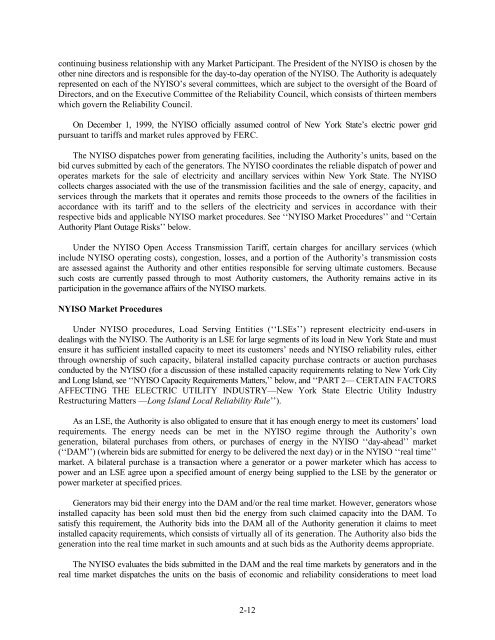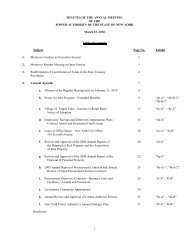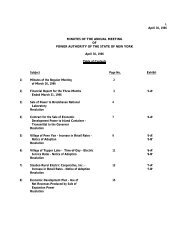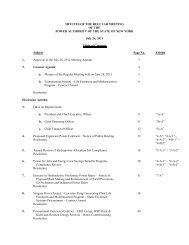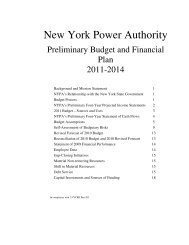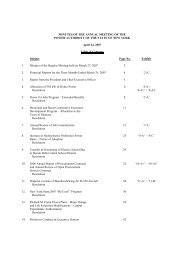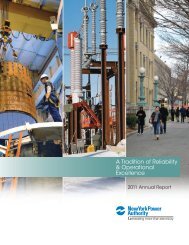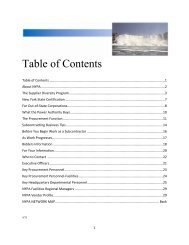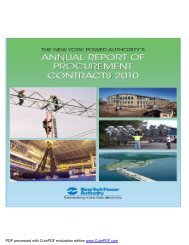July (pdf) - New York Power Authority
July (pdf) - New York Power Authority
July (pdf) - New York Power Authority
Create successful ePaper yourself
Turn your PDF publications into a flip-book with our unique Google optimized e-Paper software.
continuing business relationship with any Market Participant. The President of the NYISO is chosen by the<br />
other nine directors and is responsible for the day-to-day operation of the NYISO. The <strong>Authority</strong> is adequately<br />
represented on each of the NYISO’s several committees, which are subject to the oversight of the Board of<br />
Directors, and on the Executive Committee of the Reliability Council, which consists of thirteen members<br />
which govern the Reliability Council.<br />
On December 1, 1999, the NYISO officially assumed control of <strong>New</strong> <strong>York</strong> State’s electric power grid<br />
pursuant to tariffs and market rules approved by FERC.<br />
The NYISO dispatches power from generating facilities, including the <strong>Authority</strong>’s units, based on the<br />
bid curves submitted by each of the generators. The NYISO coordinates the reliable dispatch of power and<br />
operates markets for the sale of electricity and ancillary services within <strong>New</strong> <strong>York</strong> State. The NYISO<br />
collects charges associated with the use of the transmission facilities and the sale of energy, capacity, and<br />
services through the markets that it operates and remits those proceeds to the owners of the facilities in<br />
accordance with its tariff and to the sellers of the electricity and services in accordance with their<br />
respective bids and applicable NYISO market procedures. See ‘‘NYISO Market Procedures’’ and ‘‘Certain<br />
<strong>Authority</strong> Plant Outage Risks’’ below.<br />
Under the NYISO Open Access Transmission Tariff, certain charges for ancillary services (which<br />
include NYISO operating costs), congestion, losses, and a portion of the <strong>Authority</strong>’s transmission costs<br />
are assessed against the <strong>Authority</strong> and other entities responsible for serving ultimate customers. Because<br />
such costs are currently passed through to most <strong>Authority</strong> customers, the <strong>Authority</strong> remains active in its<br />
participation in the governance affairs of the NYISO markets.<br />
NYISO Market Procedures<br />
Under NYISO procedures, Load Serving Entities (‘‘LSEs’’) represent electricity end-users in<br />
dealings with the NYISO. The <strong>Authority</strong> is an LSE for large segments of its load in <strong>New</strong> <strong>York</strong> State and must<br />
ensure it has sufficient installed capacity to meet its customers’ needs and NYISO reliability rules, either<br />
through ownership of such capacity, bilateral installed capacity purchase contracts or auction purchases<br />
conducted by the NYISO (for a discussion of these installed capacity requirements relating to <strong>New</strong> <strong>York</strong> City<br />
and Long Island, see ‘‘NYISO Capacity Requirements Matters,’’ below, and ‘‘PART 2— CERTAIN FACTORS<br />
AFFECTING THE ELECTRIC UTILITY INDUSTRY—<strong>New</strong> <strong>York</strong> State Electric Utility Industry<br />
Restructuring Matters —Long Island Local Reliability Rule’’).<br />
As an LSE, the <strong>Authority</strong> is also obligated to ensure that it has enough energy to meet its customers’ load<br />
requirements. The energy needs can be met in the NYISO regime through the <strong>Authority</strong>’s own<br />
generation, bilateral purchases from others, or purchases of energy in the NYISO ‘‘day-ahead’’ market<br />
(‘‘DAM’’) (wherein bids are submitted for energy to be delivered the next day) or in the NYISO ‘‘real time’’<br />
market. A bilateral purchase is a transaction where a generator or a power marketer which has access to<br />
power and an LSE agree upon a specified amount of energy being supplied to the LSE by the generator or<br />
power marketer at specified prices.<br />
Generators may bid their energy into the DAM and/or the real time market. However, generators whose<br />
installed capacity has been sold must then bid the energy from such claimed capacity into the DAM. To<br />
satisfy this requirement, the <strong>Authority</strong> bids into the DAM all of the <strong>Authority</strong> generation it claims to meet<br />
installed capacity requirements, which consists of virtually all of its generation. The <strong>Authority</strong> also bids the<br />
generation into the real time market in such amounts and at such bids as the <strong>Authority</strong> deems appropriate.<br />
The NYISO evaluates the bids submitted in the DAM and the real time markets by generators and in the<br />
real time market dispatches the units on the basis of economic and reliability considerations to meet load<br />
2-12


